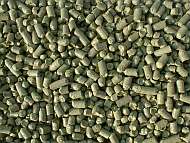Hops products
Pressed hops
Pressed hop cones is the simplest form of hop processing. Dried hop cones shipped from the grower are cleaned of any hops and non-hops admixtures. If necessary, the hops are dried to the required moisture content. The cones are then pressed by hydraulic pressers into ballots or cubes of varied weight.
Hop pellets – TYPE 90
Dried hops cones are cleaned of any hops and non-hops substances and then hops are dried to 7 – 8 % moisture. The hops are milled and granulated. The pellets dimension is 6 mm. This type of processing contributes to the product’s homogenization. The pellets are packed in layered-aluminum foil bags, where the air is replaced with nitrogen or a mix of nitrogen and carbon dioxide. The bag’s weight depends on the customers’ needs (usually 10kg). The bags are then placed in cartons and then on pallets. There is also an option of bulk packaging of the ZEWATHENER type. The final product, from the standpoint of brewery valued substances, is compatible with the hops cones product. It does have a number of other advantages, for example, a better use of all present substances during the brewing process, longer lasting and smaller product volume, easier storage, handling and shipping.
Hops pellets – TYPE 45
Dried hops cones are cleaned of any alien substances and dried to 7 – 8 % moisture. At a temperature of –35°C, the hops are pulverized and the lupuline part is separated from the plant matter on the vibration sieves. Based on initial analyses of the lupuline fraction, it is possible, by re-mixing with precisely set amounts of plant fraction, to obtain concentrated product with the required volume of alpha acids. This type of powder is then granulated and packaged in aluminum foil bags, same as in case of hop pellets type 90. The air in the bags is also replaced by inert gases. The plant fraction (waste) is granulated and used for example as animal feed. The advantage of the pellets type 45 is mainly a higher concentration of hop resins, long shelf life and significant decrease of material volume in handling, shipping and storage.

